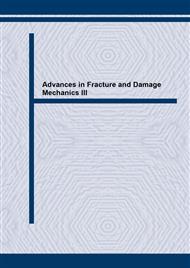[1]
G. N. Wells and L.J. Sluys, A new method for modelling cohesive cracks using finite elements. International Journal for Numerical Methods in Engineering, Vol.50-2 (2001), pp.2667-2682.
DOI: 10.1002/nme.143
Google Scholar
[2]
J. C. Simo, J. Oliver and F. Armero, An analysis of strong discontinuities induced by strainsoftening in rate-independent inelastic solids. Computational Mechanics Vol,12 (1993), pp.277-296.
DOI: 10.1007/bf00372173
Google Scholar
[3]
J. Oliver, Modelling strong discontinuities in solid mechanics via strain softening constitutive equations. Part 2: Numerical simulation. International Journal for Numerical Methods in Engineering Vol.39-21 (1996), pp.3601-3623.
DOI: 10.1002/(sici)1097-0207(19961115)39:21<3601::aid-nme64>3.0.co;2-4
Google Scholar
[4]
M. Klisinski, K. Runesson, and S. Sture, Finite element with inner softening band. ASCE Journal of Engineering Mechanics Vol.117-3 (1991), pp.575-587.
DOI: 10.1061/(asce)0733-9399(1991)117:3(575)
Google Scholar
[5]
H. R. Lotfi and P. B. Shing, Embedded representation of fracture in concrete with mixed finite elements. International Journal for Numerical Methods in Engineering Vol.38-8 (1995), pp.1307-1325.
DOI: 10.1002/nme.1620380805
Google Scholar
[6]
J. Alfaiate, A. Simone and L. J. Sluys, A new approach to strong embedded discontinuities. In N. Bicanic, R. De Borst, H. Mang, and G. Meschke (Eds.), EURO-C 2003, Computational Modelling of Concrete Structures, St. Johann im Pongau, Austria (2003), pp.33-42.
DOI: 10.1002/bate.200306470
Google Scholar
[7]
L. E. Malvern, Introduction to the Mechanics of a Continuous Medium. (New Jersey: PrenticeHall International, 1969).
Google Scholar
[8]
J. Alfaiate, G. Wells and L. J. Sluys, On the use of embedded discontinuity elements with crack path continuity for mode I and mixed mode fracture. Engineering Fracture Mechanics Vol. 69-6 (2001), pp.661-686.
DOI: 10.1016/s0013-7944(01)00108-4
Google Scholar


